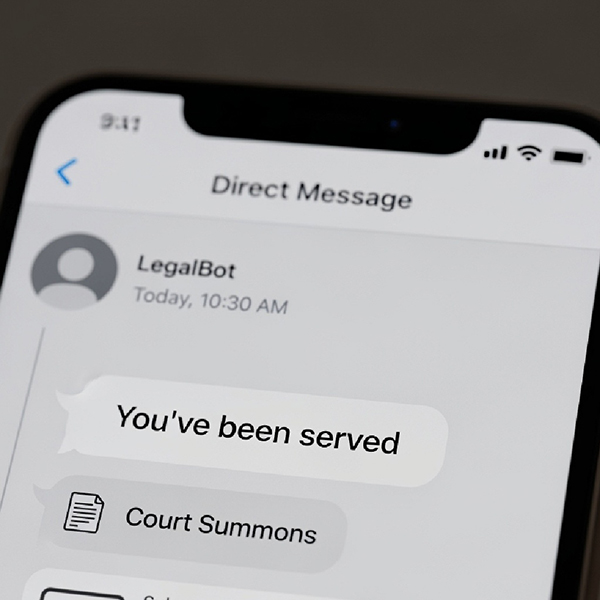Civil Procedure
Oct. 14, 2025
California OKs electronic service for elusive defendants
California's new law allowing service of summons via email or electronic media, effective January 2026, modernizes civil procedure -- but only when traditional methods are exhausted and diligence is proven.




William Slomanson
Distinguished Professor Emeritus
Thomas Jefferson School of Law
Email: bills@tjsl.edu
William Slomanson is also the author of California Procedure in a Nutshell (5th ed. 2014).

California Gov.
Gavin Newsom has signed the service via e-mail or electronic media bill into
law (filed with the California Secretary of State on Oct. 6, 2025). Its
effective date is Jan. 1, 2026. Stats.2025, ch. 403.
The basic methods of
service are set forth in Cal. Civ. Proc. §§ 413.10-417.40. As the current
version of Cal. Civ. Proc. § 413.30 authorizes: "Where no provision is made in
this chapter or other law for the service of summons, the court in which the
action is pending may direct that summons be served in a manner which is
reasonably calculated to give actual notice to the party to be served and that
proof of such service be made as prescribed by the court." Stats. 1969, Ch.
1610.
The 2026 version of
Cal. Civ. Proc. § 413.30 augments those traditional options. Subsection (a)(1)
adds that "if a plaintiff, despite exercising reasonable diligence, has been
unable to effect service of the summons by any of the methods authorized
under this chapter, the court in which the action is pending may, upon
motion, direct that summons be served ... by electronic mail or other
electronic technology...." Per subsection (a)(2): "A plaintiff seeking to
establish reasonable diligence under this section shall set forth facts
detailing all attempts to serve the defendant by each of the methods prescribed
by statute, including facts demonstrating why each method was unsuccessful at
every address or location where the defendant is likely to be found." Subsection
(b) limits this new email-social media option. It "does not apply in an action
against a governmental entity or an agent or employee of the governmental
entity who has been sued in an official or individual capacity." See
Stats.2025, ch.403 and California Senate Judiciary Committee Digest and
Executive Summary (Apr. 8, 2025), https://trackbill.com/s3/bills/CA/2025/SB/85/analyses/senate-judiciary.pdf.
This sketch offers a
cursory summary of academic and judicial assessments. It presumes state and
federal solidarity. It concludes with a potpourri of issues submerged beneath
this Brave New World iceberg. Per a New York judge's forecast: "the next frontier in
the developing law of the service of process over the internet is the use of
social media sites...."
Baidoo v. Blood-Dzraku, 5 N.Y.S.3d 709, 711 (2015) (service by
Facebook "most" comported with due process). As one writer foresaw: "email
service could be the bridge that carries service of process into the
twenty-first century." Nicki Villarrubia, Comment, Living Behind Screens: The
Case for Social Media as an Alternative Method of Service Upon Defendants, 70
Loyola L. Rev. 461 (2024) (hereafter Living Behind Screens).
An early academic
plea for adding electronic service options appeared in a Daily Journal essay.
Slomanson, "Service of process via
social media: a plea to the Legislature," Daily J. (Feb. 2, 2021), https://www.dailyjournal.com/articles/361319-service-of-process-via-social-media-a-plea-to-the-legislature.
That assessment chronicled the dearth of California authority on point. Searles
v. Archangel, 60 Cal.App.5th 43 (2d Dist., 2021) (first impression
decision barring petitioner from service by social media on homeless
respondent).
Several students and
another professor have developed a cohort of facts, law and arguments suitable
for practitioners, judges and legislators in all states. They have acknowledged
and dissected the dilemma regarding elusive defendants. See Keely Knapp, Comment,
#serviceofprocess @socialmedia: "Accepting Social Media for Service of Process
in the 21st Century," 74 Louisiana L.Rev. 547 (2014) (legal system
doing itself an injustice by ignoring this new technology); Angelea
Upchurch, "'Hacking' Service of Process: Using Social Media to Provide
Constitutionally Sufficient Notice of Process," 38 U. Ark. Little Rock
L.Rev. 559 (2016) (notice must be conspicuous, verifiable and permit sufficient
access to the lawsuit); Emily Davis, Comment, "Social Media: A Good
Alternative for Alternative Service of Process," 52 Case W. Res. J. Int'l
L. 573 (2020) (some defendants more likely to receive actual notice via this
cost-effective method). The most comprehensive analysis is presented in Living
Behind Screens.
This increasingly
conventional service alternative does not pose a direct state-federal conflict
of laws on either of two fronts. First, Fed. Rule Civ. Proc. 4(e)(1) provides
that an individual may be served by "following state law for serving summons ... [of]
the state where the district court is located or where service is made...." That
flexibility avoids inter-system conflicts -- at least in California. Second, when the defendant is in a foreign
country, an individual may be served "by other means not prohibited by [an]
international agreement, as the court orders." Ultimately, there may be
different results in the respective state, state-to-state and
state-federal contexts. But as the following cases reveal, the evolving
methodology is the same.
California's federal
courts have cleared the path on this new road to sensible service of process.
In St. Francis Assisi v. Kuwait Finance House, 2016 WL 5725002 (N.D. CA,
2016), the court granted a motion to serve an ISIS financier via Twitter. He
apparently lived in Kuwait. Mr. al-Ajmi had a large Twitter following. He
allegedly used that platform to fundraise large sums of money for various terrorist
organizations. Thus: "service by the social-media platform, Twitter, is
reasonably calculated to give notice to and is the 'method of service most
likely to reach' al-Ajmi [who] has an active Twitter account and continues to
use it to communicate with his audience. Service by Twitter is not prohibited
by international agreement with Kuwait." Id., *2.
Nine years later,
the Northern District denied service by e-mail and the WhatsApp telephone
application in Nicaragua v. Hills Exploration Corp., 2025 WL 360653
(N.D. CA, 2025) (hereafter Hills Exploration). There, petitioner
Nicaragua sought the $1.5M pecuniary obligations imposed by an arbitral award
against individuals who departed Hawaii for locations unknown, presumably in
the Philippines and Guatemala. California's Northern District and the Washington
federal district had previously approved service via e-mail. Federal courts in
New York and Utah had previously ordered service on WhatsApp. Id.,
*2-*3. But "Nicaragua [on the other hand] did not contend it has made any
attempt to locate a physical address ... or that any respondent is evading
service." Id. Furthermore, a plaintiff "must show the use of ... the
specific e-mail or WhatsApp account would be 'reasonably calculated to appraise
[defendant] ... of the pendency of the action and afford it an opportunity to
respond.' " Id., citing an extensive analysis in (the Nevada federal
court's) Rio Properties v. Rio International Interlink, 284 F.3d 1007
(9th Cir., 2002) (first impression service on Costa Rican entity, affirming
personal jurisdiction, default judgment and attorneys' fees and costs).
The Hills
Exploration court thus distinguished its denial from the St. Francis
approval of Twitter service in the following terms: "In particular, in St.
Francis Assisi, the district court approved alternative service 'via
Twitter' on a defendant located in a foreign country but did so in light of a
showing that other forms of service were not possible, such as personal
service, in that the defendant therein could not be located 'through
skip-trace,' nor could he be served through the foreign country's 'Central
Authority,' as said Central Authority 'refused to accept the summons and
complaint.' " Hills Exploration, n.3, referring to the governmental
middleman for transferring service papers within each nation's sovereign
jurisdiction.
In conclusion, a
newspaper perspective cannot be a loquacious law review discourse. It is
instead designed to acquaint the reader with a significant change in California
civil procedure coming your way on Jan. 1, 2026. It thus furnishes some insight
into a bombshell that will soon burst onto the legal battlefield. This
commentary foreshadows the following yet to be resolved issues involving
personal jurisdiction: due diligence with exhausting the traditional service
options; whether a defendant's alleged online name is in fact that of the
intended target; statute of limitations and delay of prosecution regimes
involving evasive defendants; likelihood of receipt; preponderance of evidence
skirmishes involving email versus social media service; evolving judicial
preferences among the various electronic means of service; and resolution of
the coming spotlight on default judgments.
Submit your own column for publication to Diana Bosetti
For reprint rights or to order a copy of your photo:
Email
Jeremy_Ellis@dailyjournal.com
for prices.
Direct dial: 213-229-5424
Send a letter to the editor:
Email: letters@dailyjournal.com




